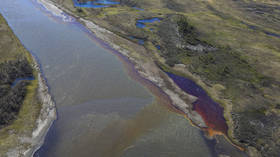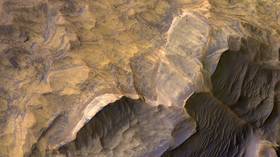As Russia ramps up climate change fight, scientists say Siberian permafrost has survived more intense heat than previously thought

Scientists at Britain’s University of Sussex have discovered that an ancient part of Siberia’s permafrost is far more resilient to heat than once thought, having survived temperatures as much as 4–5°C (39–41°F) warmer than today.
The university researchers also discovered that the ancient permafrost, known as the Batagay megaslump, is at least 650,000 years old, making it the oldest recorded in Eurasia.
Located in the remote northern Siberian Yakutia region, the megaslump is at the bottom of a crater 50m (165ft) deep and 800m (2,635ft) wide. It was found by the scientists to have experienced massive changes in weather over the years, including “exceptionally warm and wet conditions during a ‘super-interglacial’ [period] 420,000 years ago.”
Also on rt.com ‘Do we want the Earth to become like Venus?’: Putin calls for swift & practical action on the ‘huge challenge’ of climate change"Moreover, it has also survived warmer-than-present conditions about 130,000 years ago, when summer air temperatures in the Arctic may have been as much as 4–5°C warmer than during the last 11,700 years,” the Sussex researchers revealed.
Permafrost is ground that remains at or below 0°C (32°F) for at least two consecutive years. This permafrost, in particular, existing for many thousands of years, contains many ancient artifacts in pristine conduction, such as frozen animal carcasses, preserved plants, and ancient DNA.
However, with human-made changes in the environment, the megaslump’s ability to resist heat may not last forever.
“The ancient permafrost near the town of Batagay has been resilient to natural climate and environmental change over multiple glacial–interglacial cycles, but is vulnerable to human-induced disturbance,” said Professor Julian Murton, of the University of Sussex, who led the study.
Permafrost covers more than half of all Russian territory, and the country is particularly vulnerable to the impacts of global warming. Any ecological change will have enormous consequences for Russia’s infrastructure, and could have a massive knock-on effect on its economy.
Speaking last year to the Valdai Club think tank, Russian President Vladimir Putin called for an end to “unrestrained and unlimited consumption,” noting that tensions regarding climate change have “reached a critical point.”
“It affects pipeline systems, residential districts built on permafrost, and so on,” Putin explained. “If as much as 25% of the near-surface layers of permafrost – which is about three or four meters – melts by 2100, we will feel the effect very strongly.”
Putin recently intensified his rhetoric on global warming, and in April, he announced new emission quotas and proposed that there should be corporate responsibility for environmental damage.
Earlier this month, microbiologists from a Moscow research institute announced that they had revived 24,000-year-old prehistoric invertebrates from permafrost in the middle of the Alazeya River, also in Yakutia.
Think your friends would be interested? Share this story!













